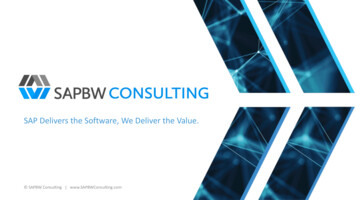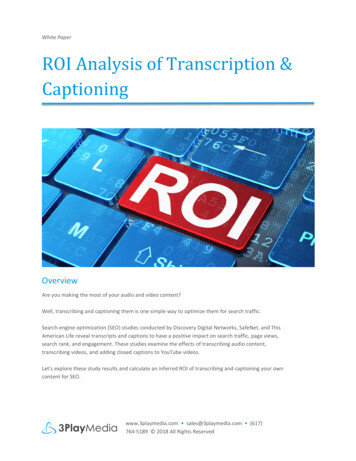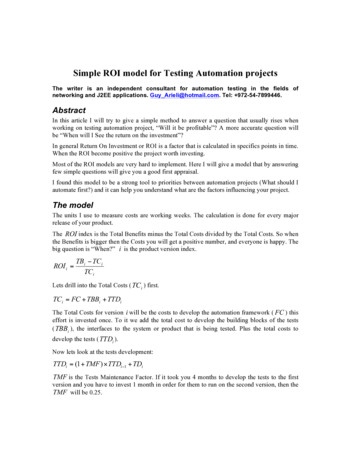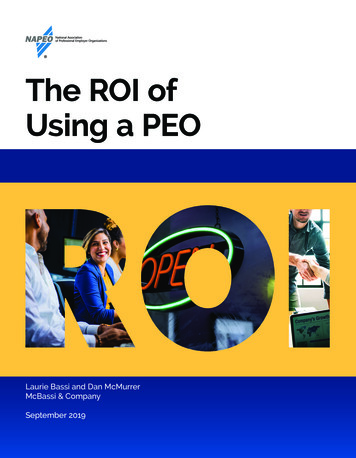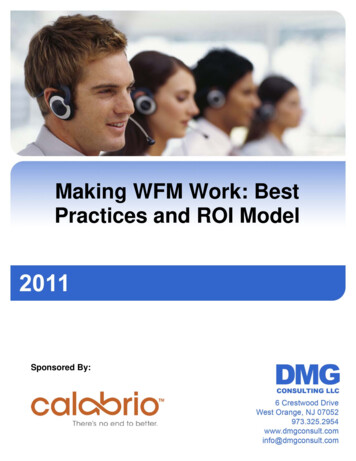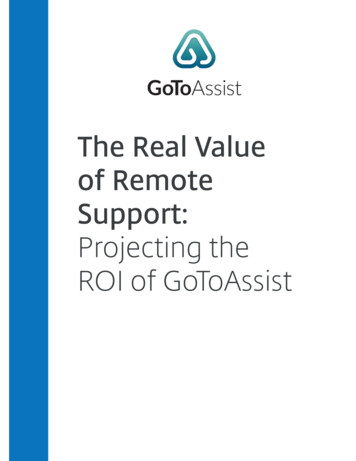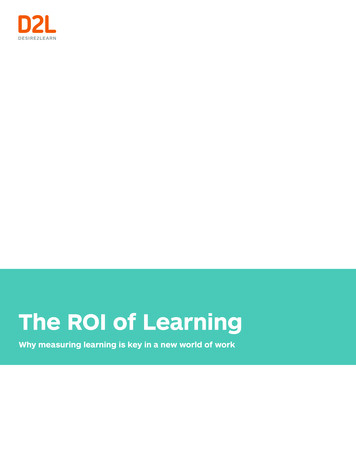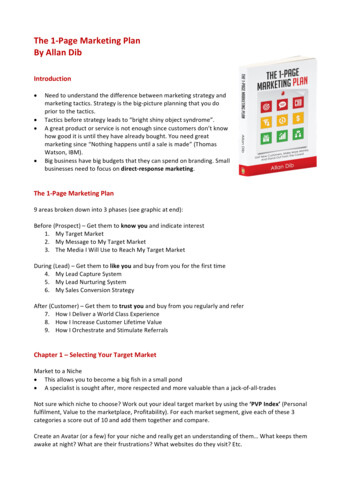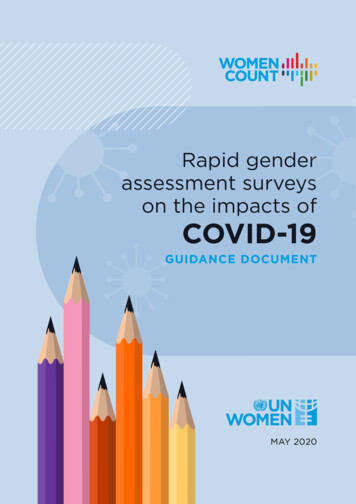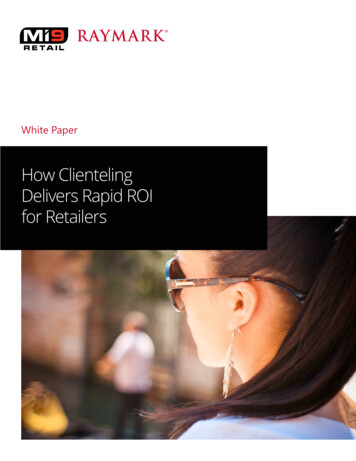
Transcription
White PaperHow ClientelingDelivers Rapid ROIfor Retailers
01 How Clienteling Delivers Rapid ROI for RetailersHow ClientelingDelivers Rapid ROI for RetailersThe primary goals of clienteling are to establish long-term relationships with keycustomers, and to empower associates tomake the most of each and every interaction.egy, and which are available when and wherethe associate needs them.By doing so, the associate is able to influence behavior related to customer frequency, average transaction value, margin, associate productivity, conversion, and more.Mosaic Clienteling was designed to enableretailers to establish long-lasting learning relationships with their customers. While it is truethat sales history provides insight into a customer’s tendencies, this insight is nowhere ascomplete as that gained by an associate working directly with a customer.Effective business processes can move thecustomer through the entire customer lifecycleof customer / client / ambassador, while providing tools to address the needs of each stepin the lifecycle.Through each interaction, the associate is ableto enhance a customer’s profile with information that cannot be easily captured in otherways. This information can then be used in future interactions, to be yet more personalizedand as a result more effective.This is best achieved by enabling associates tomanage their own business, much as an entrepreneur might. This is accomplished throughthe use of tools and enterprise informationthat support specific corporate goals and strat-Capabilities such as notes, wish lists, alerts,and purchase history provide the ability for anassociate to enhance a profile in ways that purchase history and e-commerce activity alonecannot.Copyright 2015 Mi9 Retail. All rights reserved.
02 How Clienteling Delivers Rapid ROI for RetailersThe Three Ultimate Goals of ClientelingImplementation of a clienteling solution must align with overall corporatestrategy and goals.How the solution is configured, and what features are front and center mustbe based on the targeted business processes and best practices. Often thesebusiness practices can be grouped into accomplishing one of three things:1. Increase TrafficMany of the best practices are designed to increase traffic in the store, andsubsequent recency and frequency measures. These initiatives are focusedprimarily on active outreach by the store associate(s) with the best relationship with the customer.The outreach designed to increase store traffic include a variety of purposessuch as store events, offers/promotions, new products, replenishment, etc. Allof these are designed to provide highly individualized value for the customerreceiving the communication. These initiatives are supported by apps such asfollow-up, prospects, brand alerts, queries, and templates.2. Increase ConversionOnce the customer is in the store, either through an outreach attempt orwalk-in traffic, the associate must be armed with tools to facilitate a sale. Thisis best accomplished by providing an omni-channel view of a customer, andthrough tools designed to provide product related information. By providing access to a customer’s profile, an associate may look up important notes,open offers, past purchases, wish lists, and more.By having access to product-related information, the associate can look upalternative sizes and colors, identify where products might be available, andby working directly with the customer to identify other products that may provide up-sell and cross-sell opportunities. Apps that support these capabilitiesinclude the customer profile (wish lists, notes, preferences, offers, etc.), clientbook, search, and look book.3. Increase Transaction SizeIncreasing transaction size is accomplished through the effective outreachwith personalized value propositions. By focusing outreach on items otherthan sales, the average transaction size increases dramatically. Personalizedcommunications increase the odds of a customer buying, and enhance therelationship over time.Communicating to customers about new products, cross-sell opportunities,points-based thresholds, and new affiliated brands allows the associate tofocus on effective outreach about something other than sales and promotions. Apps that support increases in transaction size include the client book,customer profile, look book, brand alerts, prospects/offers, and wish list.While most clienteling deployments vary in some ways, the fundamentals ofincreasing traffic, conversions and transaction size are the same. Retailersmust establish their strategy and goals, define the best practices and business processes that support these goals, configure a solution to enforcethese business, and educate and empower their associates to execute.Copyright 2015 Mi9 Retail. All rights reserved.
03 How Clienteling Delivers Rapid ROI for RetailersCASE STUDYCase Study HistoryThe customer profiled in this case study is one of the largestluxury department store chains in the United States. Theiroriginal store, which was opened nearly a century ago in NewYork City provided a unique specialty store that would becomesynonymous with fashionable, gracious living.The retailer’s mandate is to offer the finest quality men’s andwomen’s fashions as well as an extraordinary program of customer service. They now own and operate over 100 full lineoutlet locations across the United States as well as licenseagreements for six international locations.While the retailer has had a form of clienteling for many years,first with a system created by a software vendor Cornell Mayo inthe late 1990s, and then with the Retaligent Clarience application deployed in 2006, they wished to implement a new clienteling solution focused on omni-channel and mobile strategy. Thenew clienteling initiative was to combine the best of the existingstrategies, with a new single view of the customer on a mobileplatform.Project GoalsThe primary goal of the clienteling solution is to provide toolsand data to in-store associates to manage their top customers.Understanding the 80/20 rule of retail, where 80% of sales arederived from 20% of the customers, the retailer’s focus is to influence the buying behavior of these top tier customers throughhighly personalized relationships provided by each associate inthe retail environment. While this is the primary focus, the toolsetneeded to also be designed with an eye toward the averagewalk-in customer, since influencing each and every sale can havedramatic impact on the bottom line.The primary goals for the project were as follows: Establish lasting relationships with the most important clients; Empower associates to become entrepreneurs and managetheir own business; Provide tools to address three phases of the customer lifecycle(customer/client/ambassador); Improve associate productivity through targeted and personalized outreach to customers; Improve conversion through tools to facilitate product knowledge and availability; Increase the average transaction size for affiliated customers; To increase customer frequency for affiliated customers.To meet these goals, the Raymark team worked with the retailerto understand the features and deployment options which wouldbest meet their specific needs. This was done through a BestPractices and Business Process Review, with the end result beinga list of omni-channel initiatives, and the supporting businessprocess to execute these initiatives.The primary business processes focused on three phases of asale:Before the SaleActive outreach to customers about unique personalized valuepropositions, the ability to identify customers most likely torespond to specific communications, as well as appointmentpreparation.During the SaleProvide access to customer information (purchases, likes, promotions, offers, loyalty points, etc.), product information (alternatives, availability, knowledge, upsell opportunities), and serviceinformation (repairs status, alterations status, etc.). In addition,to provide tools to enhance the profile with valuable informationgathered during an interaction such as notes, preferences, wishlists, relationships, etc.)After the SaleProvide tools to perform accurate follow-up, execute relationship building outreach (thank you, birthday), and to schedule the“next” interaction.ResultsThe Mosaic Clienteling solution was deployed to over 3000associates with a wide range of features, each designed to address one or more business processes in the retail organization.The clienteling strategies employed by this retailer are detailedthroughout the remainder of this document.Copyright 2015 Mi9 Retail. All rights reserved.
04 How Clienteling Delivers Rapid ROI for RetailersClienteling OverviewMosaic Clienteling is based on new technology that enables Raymark to delivera beautiful cross-platform experience,however the concepts incorporated inthe application are based on decadesof developing solutions for store associates with a primary goal of fosteringlong-term learning relationships between individual associates and customers. Mosaic Clienteling provides thetools needed to empower associatesto effectively manage their businessas sales professionals.The Mosaic platform was designed tobe data agnostic (be able to consumedata from a variety of data sources),OS agnostic (run on a PC as well asa variety of mobile devices), and beconfigurable and extensible (customexperience by retail brand).Many studies have been performed thatdemonstrate the value of relationshipsin retail sales. In one study performedby Retail Wise Consulting, it was demonstrated that the average customerwho shops 2 or more times with aretail brand spends twice as much ifthey work with the same associate asopposed to different associates.The 80/20 RuleFor most retailers another tenet is alsotrue – 80% of sales are derived from20% (often less than 20%) of customers. This 80/20 rule demonstrates thevalue of a dedicated focus on the toptier customer, as a 5% gain in sales fromthese customers represents a muchgreater benefit than a 10% gain with allother customers combined. And it is fareasier to influence the loyal customerthan the customer who is not yet loyalto the brand.For these reasons, a typical clientelinginitiative in retail is designed to providea targeted focus on the top tier of customers with the end goal of enhancingthe relationship with this customer atboth the brand, and the individual associate level. While the typical sale is not tobe ignored (and in fact can be impacteddramatically with the right tools), themain emphasis of a clienteling initiativeis on influencing the interaction with aselect group of clients.dressed through a concept referred toas affiliation. An affiliation is most oftena voluntary relationship set by the storeassociate whereby the associate electsto put a customer in their client book.Associates are essentially mandated tobuild their book of qualified customersfrom which to work. The shortcomingof this approach, however, is that someassociates may not be aware of thepotential value of a given customer, andsome of the potential high-value customers might slip through the cracks. Asa result, the solution must also take intoaccount these unaffiliated customersfor targeted and personalized service aswell. The Mosaic solution was designedto address all of these needs.The Customer LifecycleIn fact, the business process and supporting software must address threephases of a customer lifecycle:1. The first time shopper (customer)2. Repeat sale (client)3. Loyal customer (ambassador)The average retailer considering a clienteling solution is looking to formalizespecific business processes in an effortto accomplish a combination of overallbusiness goals such as: Increase Sales Increase Margin Increase Visits Increase Average Transaction Increase Associate Productivity Increase ConversionA clienteling deployment, therefore,is designed for each retailer in orderto match the business process to theformalized goals of the organizationand to align with the corporate strategyfrom the top down. By understandingthe impact of relationships, and specifically relationships with the top tier ofcustomers, a retailer is best equipped todesign and support store best practicesthrough a formalized business process,and is still better equipped to do sothrough a software solution.From a solution standpoint, this is adCopyright 2015 Mi9 Retail. All rights reserved.
05 How Clienteling Delivers Rapid ROI for RetailersCLIENTELINGAPPSCUSTOMER PROFILEprovides a detailed analysis of customer spend by category andchannel.The customer profile represents both the summary and detailed information related to a customer, as well as the tools thatspecifically relate to a customer. The customer profile is available through a majority of the apps, but provides a number offeatures related to existing customer data, or enhancing the customer information through each interaction with the customer.The customer profile consists of two forms of navigation (top five,navigation bar), and access to a wide range of customer information and tools to enhance the profile through omni-channelcustomer data capture.AffiliationTop FiveThe top five feature is designed to provide quick access to customer information related to the five most important items anassociate may wish to know when working with a client. Thesecustomizable items may consist of:Loyalty Account StatusIf the customer is a member of a loyalty program, this area of theprofile displays the tier, spend, points, and other important information related to their account. It also provides a more detailedview of the account information by quick navigation to the detailspage.Bonus Reward ValueThe bonus reward view is related to any valid points that havebeen accrued, but not yet redeemed.Current OffersThe current offers feature is designed to notify an associate ifthe customer has received any personalized marketing offers orpromotions. The navigation provides a view of all offers provided,as well as a details page consisting of the content and applicableoffer/promo code and/or barcode.Last TransactionThe last transaction summary provides a quick view of the dateand value of the last transaction. The quick navigation provides adetailed view of the specific transaction.The affiliations feature provides a quick view of those other associates who may have a relationship, as well as a mechanism toadd a customer to an associate’s client book.Contact InformationContact information provides a view of the customer’s contact information including multiple addresses, phone numbers, e-mails,and SMS approved mobile numbers. In addition, the contactinformation feature also provides an indicator of customers’contact preferences, as well as any contact method for which thecustomer has opted out.Purchase HistoryThe purchase history section, pictured above, provides a series oftabbed pages, each with a different view of past transactions.The primary view is a photo gallery view of all items purchased.This gallery view allows the associate to visually identify the pastpurchases, and to filter this view by category, by brand, as well asto view items purchased with the logged-in associate.The second view is the transactions view, which displays a grid ofpast purchases by transaction summary. Selecting a transactionprovides a pop-up view of the items within that transaction. Thesame filters apply to this view as described in the gallery view.The third view is the item view, which displays a grid of all itemspurchased by the customer with all associated detail – includingUPC, style, brand, color, size, price, etc. The filters described inthe gallery view apply to this tab as well.The final view is a summary of spend by category across all channels. This view is not controlled by the filters, but rather providesdetailed spend this year and last year by category and channel.Category SummaryThe category summary displays the three most popular productcategories purchased by the customer. The quick navigationCopyright 2015 Mi9 Retail. All rights reserved.
06 How Clienteling Delivers Rapid ROI for RetailersFollow-UpOutreachThe follow-up module was designed to display all follow-up opportunities with a customer. This is closely tied to the follow-upapp, described below, and consists of follow-up opportunitiescreated by the associate, as well as follow-up opportunities created by marketing or automatic workflows related items such asalterations, holds, sends, birthday reminders, replenishments,and other automated reminders.The outreach module enables the associate to reach out to theircustomers through the solution itself. It provides the featuresto send an e-mail, make a phone call (with cell-enabled device),send a text (with text-enabled device), or to print a letter to bemailed. In addition to the capabilities to perform these tasks,the outreach module also provides for the selection of pre-builttemplates, or for free-form writing of e-mail, SMS or letters withthe ability to attach a file, insert an image, as well as to insert“mail-merge tokens” whereby the customer and associate namesare auto-populated in a pre-defined template.NotesThe notes feature enables an associate to make detailed notesrelated to a customer, and to view prior notes to identify anyitems of importance. This notes field can also be queried throughthe query app (described below), enabling the associate to find allcustomers that have notes related to a specific topic.PreferencesThe preferences module enables associates to record and viewinformation about the customer’s product, shopping and personal preferences, and consists of two tabs: preferences and brandalerts. The first tab enables retailers to create custom surveyquestions to collect personal information about the customer.The second tab allows the associate to request an alert for anyproduct that is received in the store related to a specific brandand/or category of merchandise. For example, a shoe associatemight create a brand alert for all incoming Prada Shoes so asto be alerted to their arrival with the opportunity to then viewthe merchandise to perform an outreach to the customer if theincoming shoes match a customer’s preferences. These alerts willappear in the follow-up app as described below.Wish ListThe wish list feature enables the associate to add items to acustomer’s wish list by either scanning an item into the list, orby searching for an item. Through integration with e-commerce,this list can also be populated by the customers themselves andmanaged on the public website. Workflows can be configuredto alert associates of items on a wish list that fall under promotions, discounts or other product related events. The wish listalso supports relationship selling, by encouraging reaching outto a customer’s spouse based on date related events (such asbirthday or anniversary).RelationshipsThe relationships feature enables an associate to identify relationships between a customer and other customer profiles.These relationships can be defined as spouse/partner, familymember, associate, etc. These relationships support a few keybusiness processes: 1) by providing the ability to link a sendtransaction directly to a relationship profile at POS and 2) toprovide opportunities to perform outreach to those with relationships for key events.Contact InfoLAST 60Creating follow-ups for customers, as well as identifying andaffiliating customers can take time that an associate may nothave while working on the floor on a busy day. The last 60 appwas designed to address this issue, and to assist the associate inmanaging their day. Last 60 provides a real-time view of the associate’s last 60 transactions (can include newly created profiles,sales, returns and other special transactions), and the relatedcustomers.The last 60 app allows the associate to review each of the customers with whom they have worked, and to pe
Implementation of a clienteling solution must align with overall corporate strategy and goals. How the solution is configured, and what features are front and center must be based on the targeted business processes and best practices. Often these business practices can be grouped in

